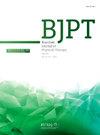Interrater reliability of a new tool to analyze sagittal parameters in camptocormic patients: The 3D morphological analysis system SAM3D®
IF 3.2
3区 医学
Q1 ORTHOPEDICS
引用次数: 0
Abstract
Background
Camptocormia is a trunk flexion occurring during walking that the patient can spontaneously correct in a static position. Therefore, capturing the flexed trunk posture on radiograph is difficult.
Objective
To analyze the interrater reliability in different positions reflecting the dynamic phenomenon of camptocormia using a non-invasive visual three-dimensional capture tool.
Methods
Sample size calculation was at least 31 participants. 34 patients who had camptocormia and were monitored in our clinical practice were included. Two different examiners performed measurements using SAM3D tool in the three following positions: Spontaneous Standing Position (SSP), Upright Standing Position (USP), and Walking-like Standing Position (WSP). Sagittal parameters were measured: arrow in C7, kyphosis, lordosis, and knee flexion. The interrater reliability was assessed using Lin's Concordance Correlation Coefficient (CCC).
Results
Regarding the arrow in C7, the Lin's CCCs were excellent, respectively 0.96 (SSP), 0.98 (USP), and 0.97 (WSP). All the CCCs for other parameters were at least fairly good (>0.87). There were significant differences in arrows in C7 between USP and the two other positions (SSP and WSP).
Conclusion
SAM3D is a non-invasive visual three-dimensional capture tool allowing safe and automatic assessments, and repeated measurements with good interrater reliability.
一种分析喜树状体患者矢状面参数的新工具:三维形态分析系统SAM3D®
喜树畸形是行走时发生的躯干弯曲,患者可以在静止位置自发纠正。因此,在x光片上捕捉躯干屈曲的姿势是困难的。目的利用无创视觉三维捕捉工具,分析反映喜树虫动态现象的不同位置的判读信度。方法样本量计算至少为31人。34例喜树豆病患者在我们的临床实践中被监测。两名不同的检查人员使用SAM3D工具在以下三种位置进行测量:自发站立位置(SSP),直立站立位置(USP)和步行站立位置(WSP)。矢状面参数测量:C7箭头、后凸、前凸和膝关节屈曲。信度采用Lin’s Concordance Correlation Coefficient (CCC)进行评估。结果C7箭头的Lin’s CCCs优良,分别为0.96 (SSP)、0.98 (USP)和0.97 (WSP)。其他参数的CCCs至少相当好(>0.87)。在C7中,USP与其他两个位置(SSP和WSP)的箭头有显著差异。结论sam3d是一种无创的视觉三维捕获工具,可进行安全、自动的评估,且可重复测量,具有良好的相互可靠性。
本文章由计算机程序翻译,如有差异,请以英文原文为准。
求助全文
约1分钟内获得全文
求助全文
来源期刊
CiteScore
6.10
自引率
8.80%
发文量
53
审稿时长
74 days
期刊介绍:
The Brazilian Journal of Physical Therapy (BJPT) is the official publication of the Brazilian Society of Physical Therapy Research and Graduate Studies (ABRAPG-Ft). It publishes original research articles on topics related to the areas of physical therapy and rehabilitation sciences, including clinical, basic or applied studies on the assessment, prevention, and treatment of movement disorders.

 求助内容:
求助内容: 应助结果提醒方式:
应助结果提醒方式:


